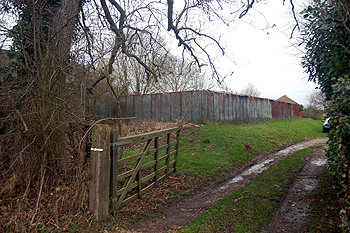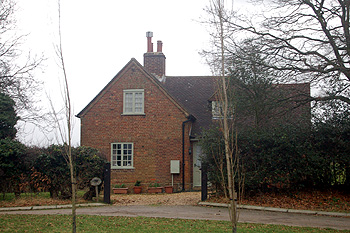
The former swimming pool January 2012
In 1912 the Duke of Bedford built a swimming pool for the residents of Husborne Crawley. The contract was with Brims & Company Limited of Newcastle-upon-Tyne [Northumberland] who were also contracted to build the water tower in Ridgmont. [HN10/360/Bedford4]. The duke's total expenditure on the project was £1,265, a considerable sum at the time. The swimming pool was built between the Experimental Farm and 71 and 73 Mill Road.
The Rating and Valuation Act 1925 specified that every building and piece of land in the country was to be assessed to determine its rateable value. The valuer visiting Mill Road found that the swimming pool [DV1/A8/36] had twelve dressing rooms. The pool itself measured 25 feet by 10 feet and had a capacity of 60,000 gallons of water. The shallow end measured 3½ feet and the deep end 6 feet deep.
A pumping station stood behind the pool. It measured 17 feet by 30 feet by 10 feet high and had foundations one foot deep. It contained an oil engine and the pump itself. The swimming pool did not have a long life, becoming disused well before the end of the century, though the structure itself survives.
The original attendant at the swimming pool and also in charge of the pump house was Alfred Charles Rowberry. He died on 22nd September 1914, being one of over 1,300 men lost on three obsolete armoured cruisers: Hogue, Aboukir and Cressy sunk by German U-boat U9 in the North Sea. The Bedfordshire Times reported that Rowberry, a Petty Officer Stoker, had been a naval reservist and so had been called up at the beginning of the war. A later edition of the same paper described him as "a fine manly fellow, and highly respected in the neighbourhood. He left a wife and one child."

Lake Cottage January 2012
Lake Cottage stands on the east side of Mill Road and is so called because it overlooks the former area of a brick kiln and pit which has been filled with water and is now used for private fishing.
The Rating and Valuation Act 1925 valuer visiting the cottage found it tenanted by Frank Carter who paid rent to the Duke of 18/7 per quarter. His substantial accommodation comprised three living rooms and a kitchen downstairs with four bedrooms above. A washhouse, coal barn and earth closet stood outside. He fetched his water from the lake and the house was lit by oil lamps.

71 and 73 Mill Road January 2012
Husborne Crawley has fifteen blocks of Bedford Estate cottages, mostly built in the 1850s and 1860s. They can be found in Crow Lane, Horsepool Lane, Mill Road, Ridgmont Road, School Lane and Turnpike Road. Some were listed by the former Department of Environment, which gave a general background as follows: "The 7th Duke of Bedford recognised the advantages of housing agricultural labourers in comfortable dwellings. From the late 1840's onwards the emphasis in Bedford Estate cottage building was on the utilitarian rather than the Picturesque. The cottages are not only remarkable for the high quality of construction at such an early date, but also represent an influential contribution to the development of working class housing which culminated in the garden cities and early council housing. The Dukes of Bedford built about 500 cottages in the locality between the 1840's and World
War One. The brickwork seems to be an early type of cavity walling".
71 and 73 Mill Road are classic Bedford Estate cottages, though built much later than the majority in Husborne Crawley, having a date stone of 1912. They comprised a living room, kitchen and scullery downstairs with three bedrooms above. A coal barn, a washhouse and an earth closet stood outside.
Being built after the pumping station the cottages had water laid on. However, they had no electricity, being lit by lamps and no flushing toilets, simply earth sanitation. 71 was occupied by Frank Circuitt who paid rent of three shillings per week. 73 was in the occupation of Edward Garrett.